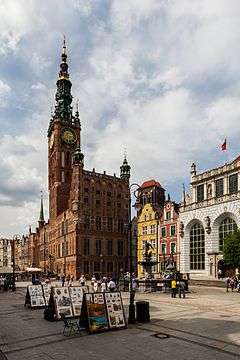Gdańsk Town Hall
| Gdańsk Town Hall | |
|---|---|
| Ratusz Głównego Miasta w Gdańsku | |
 Main Town Hall in Gdańsk | |
| General information | |
| Type | Town hall |
| Architectural style | Renaissance-Baroque |
| Location | Gdańsk, Poland |
| Construction started | 1346 |
| Completed | 15th century |
| Height | 83.45 metres |
| Historical Museum of the City of Gdańsk | |
Gdańsk Main Town Hall is a historic Ratusz located in the Gdańsk Main City borough of Śródmieście. It is one of the finest examples of the Gothic-Renaissance historic buildings in the city, built at the intersection of the Long Lane and Long Market, in the most popular part of Gdańsk.[1] The Main Town Hall in Gdańsk houses the History Museum of the City of Gdańsk.[2]
Location
The Main Town Hall in Gdańsk is located at Long Lane, part of the Royal Route. The building is located in the building complex, surrounded by Long Lane, Kramarska Street, Piwna Street, and Kaletnicza Street, located at the corner of the first two. The building is the second highest building in the Main City, after St. Mary's Church, the building is in the most notable part of the Śródmieście in Gdańsk. Access to the building by car is difficult, as the Long Lane surrounding the building is pedestrianised all year around. The public transport does not reach the building. The closest tram stop is located at Podwale Przedmiejskie.[3]
History
The oldest fragments of the town hall come from 1327 to 1336 - the building was then much smaller in size, which led to its expansion in the subsequent years. In the fourteenth-century the Main City of Gdańsk was reconstructed, and in 1346 replaced the then enforced Lübeck law with the Kulm law. The reform had separated the roles of the city council and ława miejska (which was responsible for the judiciary). The separation of the two bodies led to the need for two separate halls for the two institutions. In 1357, in the location of the current town hall, a temporary town hall was located.[4]
The first major expansion of the building began in 1378, after the full Kulm law was given to the city. The expansion of the building was led by Henryk Ungerdin, and the reconstruction was complete in 1382. Between 1454 and 1457, with the relation of the arrival of King Casimir IV Jagiellon, the town hall was expanded. The town hall's tower was complete in the years of 1486-1488; the building of which was led by Henryk Hetzel. The tower was completed by Michał Enkinger, with a high dome in 1492, which had burnt down in 1494. In 1504, the town hall was visited by King Alexander Jagiellon.[5]
After a fire in 1556, the town hall was rebuilt and expanded with Renaissance influences by Dutch architects and master-builders, including Wilhem van den Meer, Dirk Daniels, and Anthony van Obberghen.[6]
References
- ↑ "Main Town Hall In Gdańsk". MHMG. Retrieved 10 March 2016.
- ↑ Piasecki, Tadeusz Glinka, Marek (2004). Perły architektury. Poznań: Wydawn. Podsiedlik-Raniowski i Spółka. ISBN 8373414029.
- ↑ Żak, Lech Krzyżanowski, Marek (2008). Gdańsk - Perła Bałtyku : historia, architektura, sztuka. [S.l.]: Oficyna Wydawnicza Excalibur. ISBN 8391607879.
- ↑ al.], [red. prowadzący Tomasz Kaliński ; oprac. i red. map Jarosław Talacha ; treść turystyczna Paweł Zalewski ; aut. opisów Patryk Grabski et (2008). Polska (Wyd. 3. ed.). Warszawa: Carta Blanca. Grupa Wydawnicza PWN. ISBN 9788360887356.
- ↑ Domagała, Tadeusz (1980). Ratusz Głównego Miasta w Gdańsku. Warszawa: Sport i Turystyka. ISBN 8321722946.
- ↑ Maria Bogucka, "Town Hall as Symbol of Power: Changes in the Political and Social Functions of Town Hall in Gdansk till the End of the XVIIIth Century" in Acta Poloniae Historica, 75 (Warsaw, 1997) and also in the author's collection of essays Baltic Commerce and Urban Society, 1500-1700: Gdańsk/Danzig and its Polish Context (Adlershot, UK: Ashgate, 2003)
- Muzeum Historyczne Miasta Gdańska (2016), Ratusz Głównego Miasta. History. Visitor information.